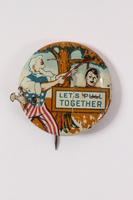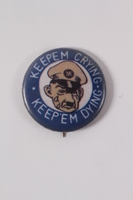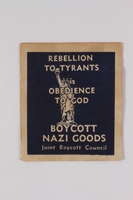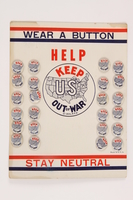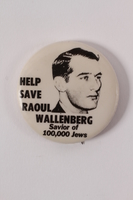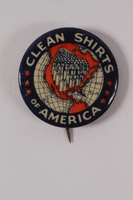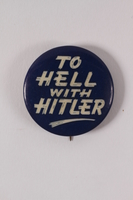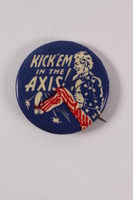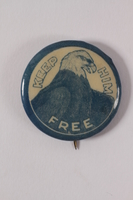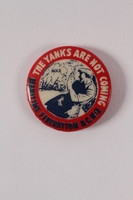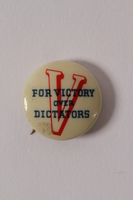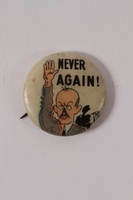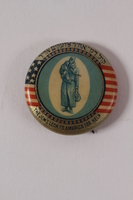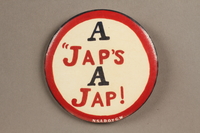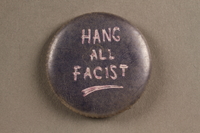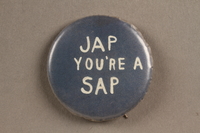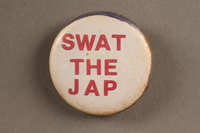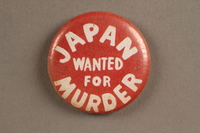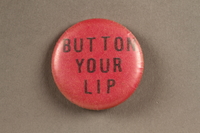Overview
- Brief Narrative
- Take a Punch game encouraging people to buy US Defense bonds and stamps; in red, white, and blue with a caricature of Hitler next to a swastika in the left corner. In the right corner is a large 2 cent symbol. It includes instructions on how to play the game.
- Credit Line
- United States Holocaust Memorial Museum Collection, Gift of Forrest James Robinson, Jr.
Physical Details
- Classification
-
Toys
- Category
-
Games
- Object Type
-
Novelties (lcsh)
- Dimensions
- overall: Height: 9.190 inches (23.343 cm) | Width: 7.310 inches (18.567 cm)
Rights & Restrictions
- Conditions on Access
- No restrictions on access
- Conditions on Use
- No restrictions on use. No copyright information is known.
Administrative Notes
- Legal Status
- Permanent Collection
- Provenance
- THe game board was donated to the United States Holocaust Memorial Museum in 2019 by Forrest J. Robinson Jr.
- Record last modified:
- 2024-03-19 08:41:11
- This page:
- https://collections.ushmm.org/search/catalog/irn652206
Download & Licensing
In-Person Research
- By Appointment
- Request 21 Days in Advance of Visit
- Plan a Research Visit
- Request to See This Object
Contact Us
Also in Forrest James Robinson Jr. collection
The collection consists of anti-Nazi, political, and other wartime propaganda materials.
Date: 1940-1945
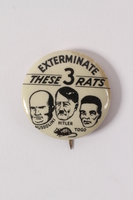
Anti-Axis pin calling for the extermination of Axis rats
Object
Anti-Axis pin-back button distributed in the United States during World War II. The button compares the leaders of Germany, Italy, and Japan to rats and calls for their extermination. The name under the Japanese face, referred to as Togo, may refer to Shigenori Tōgō, who was Minister of Foreign Affairs at the beginning of the war. The name may also be a misspelling of Tojo, a reference to Hideki Tojo who was Prime Minister of Japan during the war and a more popular target of American propaganda. After the Japanese surprise attack at Pearl Harbor on December 7, 1941, and Germany’s declaration of war four days later, a wave of American patriotism and anti-German, Italian and Japanese sentiment swept through the country. Much of this was manifested through pieces of ephemera such as posters, buttons, pins, cards, toys and decals. Often such pieces would depict unflattering or caricatured images of the Axis leaders along with a call to action for the public to aid in their defeat. This sentiment continued in America until the end of the war.
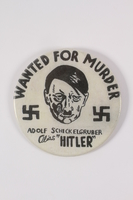
Hitler Wanted for Murder pin
Object
Anti-Nazi pin-back button distributed in the United States during World War II. The pin falsely claims that Adolf Hitler’s real name is Adolf Schicklgruber (misspelled on the pin as Schickelgruber). An assertion which was originated by Hans Habe, a Viennese Jewish writer. The claim was based on the last name of Hitler’s father, who was born Alois Shicklgruber. Before Hitler was born, Alois changed his name and it became Alois Hitler. The motif of Hitler’s “real” name was likely an attempt to ridicule the leader and belittle him to the public. Buttons of this type came in various sizes, ranging in diameters from under 1 inch to 3.5 inches. The Adolf Schicklgruber motif was also used on other ephemera, such as posters. After the Japanese surprise attack at Pearl Harbor on December 7, 1941, and Germany’s declaration of war four days later, a wave of American patriotism and anti-Axis sentiment swept through the country. Much of this was manifested through pieces of ephemera such as posters, buttons, pins, cards, toys and decals. Often such pieces would depict unflattering or caricatured images ridiculing the Axis leaders, along with a call to action for the public to aid in their defeat. This sentiment continued in America until the end of the war.
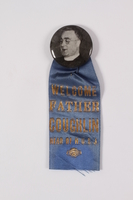
Pin-back button
Object
Pin featuring an image of Father Charles Coughlin, a Canadian-American Catholic priest and antisemitic radio host.
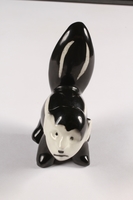
Ceramic figurine of a skunk with Adolf Hitler's face
Object
Figurine of a skunk painted in black and white with the frowning face of Adolf Hitler and the words "Japan's Rising Sun" painted in gold lettering along the tail. There is also an image of a gold sun underneath the letters.
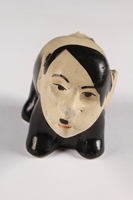
Ceramic figurine of a skunk with Adolf Hitler's face
Object
Figurine of a skunk painted in black and white with the face of Adolf Hitler. The tail is broken off from the body.
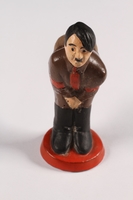
Plaster figurine of Adolf Hitler with pincushion
Object
Painted figure of Adolf Hitler bending over with a brown fabric pincushion as his bottom. These Anti Axis pin cushions were sold in 1941 to support war efforts. Includes original tag titled "Hotzi Notzi" and two pins with paper American flags.
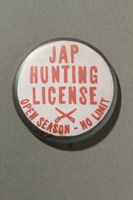
Pin-back button
Object
American propaganda anti-Japanese pin-back button, "Jap Hunting License/Open Season/No Limit" and image of crossed weapons.
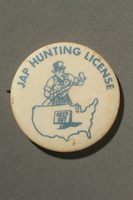
Pin-back button
Object
American propaganda anti-Japanese pin-back button, "Jap Hunting License" with outline of map of United States, a "Keep Out" sign and a likeness of Uncle Sam, holding a rifle.
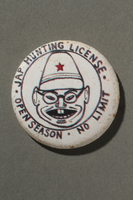
Pin-back button
Object
American propaganda anti-Japanese pin-back button. "Jap Hunting License/Open Season/No Limit." Lettering around image of a Japanese person with stereotypical features and a red star on his military cap.
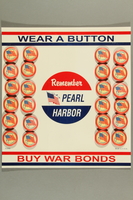
Display board with pins
Object
Display board with series of American propaganda anti-Japanese pin-back buttons. Display board reads "Wear a Button/Remember Pearl Harbor/Buy War Bonds", and each identical pin has the words "Remember Pearl Harbor" and an American flag. The board is dated 1942.
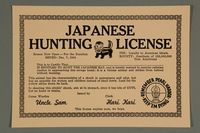
American anti-Japanese "hunting license"
Object
American propaganda document: anti-Japanese "hunting license." Satirical "Japanese Hunting License" document with no names filled in.
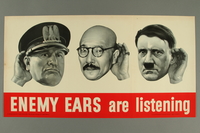
American propaganda poster depicting Mussolini, Tojo, and Hitler listening for information
Object
Poster depicting the heads of Axis leaders, Benito Mussolini of Italy, Hideki Tojo of Japan, and Adolf Hitler of Germany, above a clear warning. Each man is holding a hand cupped to one ear, suggesting that he is listening carefully for any careless talk revealing valuable information about the United States or their allies. The poster was designed by Ralph Iligan, an artist working for the Graphics Division of the United States Office of War Information, in 1942. The need to manage information about the war on the home front led to the establishment of the OWI in June 1942. This office controlled the design and distribution of war information to the American public in print, radio, and film media. The OWI commissioned work from leading artists to create posters to inspire and instill confidence and patriotism in the American public. The OWI also ran information campaigns for civilian agencies, War Bond drives, and campaigns to ramp up economic production for the war effort. New posters were distributed every two weeks, with the stated goal of placing posters in every city and town in the United States.
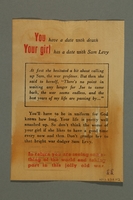
German propaganda leaflet
Object
Leaflet: "What about calling up Sam Levy..."; dated January 1945; in English
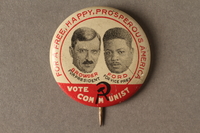
Earl Browder and James Ford 1940 campaign button
Object
1940 election campaign button with images of Earl Browder and James Ford and the words "For a Free, Happy Prosperous America/Browder for President Ford for Vice Pres./Vote Communist."
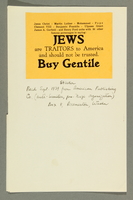
Sticker
Object
Sticker, "Jews are TRAITORS to America and should not be trusted. Buy Gentile"; 1939.
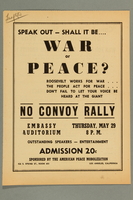
Leaflet
Object
Leaflet, "Speak Out - Shall it be War or Peace?...No Convoy Rally" Los Angeles; American Peace Mobilization, 1941.
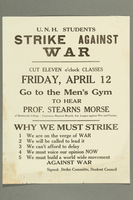
Broadside
Object
Broadside announcing a strike of University of New Hampshire students against war, Friday, April 12.
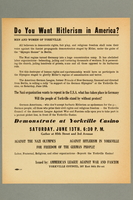
Leaflet
Object
Leaflet, "Do You Want Hitlerism in America?. American League Against War and Fascism; 1936.

Broadside
Object
Broadside, “No A.E.F. Day / November 11th” for Armistice Day Rally “Keep Out Of War”
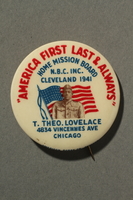
Pin
Object
Pin, “America first last & always / Home Mission Board / N.B.C. Inc. / Cleveland 1941” with image of soldier in front of American flag; from “T. Theo. Lovelace / 4834 Vincennes Ave. / Chicago”
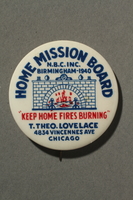
Pin
Object
Pin: “Home Mission Board / Keep home fires burning” with image of fireplace; from “T. Theo. Lovelace / 4834 Vincennes Ave. / Chicago”
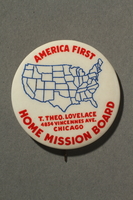
Pin
Object
Pin, “American First / Home Mission Board” with central image of map of United States; from “T. Theo. Lovelace / 4834 Vincennes Ave. / Chicago”
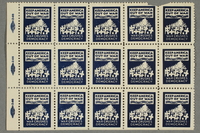
Block of stamps
Object
Block of stamps, “Keep America / Out of War” above field of crosses with “War Crushes / Democracy” at bottom
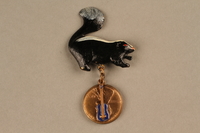
Der Phew-er Hitler Skunk S(cent) Penny Guitar Brooch
Object
Der Phew-er Hitler Skunk S(cent) Penny Guitar Brooch; 1940
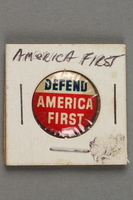
Pin-back button
Object
Anti-Roosevelt, pro-Willkie 1940 presidential campaign button
Object
Anti-Roosevelt, pro-Willkie campaign button for the 1940 Presidential Election. Several variations of this button were manufactured at a rapid pace. Some had different background colors, while others had different text size and font styles. The campaign button was used to build awareness, and encourage positive word of mouth for the Republican challenger, Wendell Willkie, while simultaneously discouraging support for the Democratic incumbent, Franklin Delano Roosevelt (FDR). FDR was running for an unprecedented third term, which was a major factor the Republicans pressed during the campaign. Willkie also challenged FDR’s New Deal policies and his approach to the ongoing World War. After Willkie was defeated by FDR, he became an ally of the President. Willkie called for greater national support for the Lend-Lease Act, embarked on a new campaign to awaken America from its isolationist slumber and urged unlimited aid to Britain in its struggle against Nazi Germany.
Anti-Roosevelt 1940 Presidential Campaign button
Object
Anti-Roosevelt campaign button for the 1940 Presidential Election. Several variations of this button were manufactured with different text size and font styles. Campaign buttons were used to build awareness, and encourage positive word of mouth for the candidates. In the 1940 Presidential election incumbent president, Franklin Delano Roosevelt (FDR) was running against Republican challenger, Wendell Willkie. FDR was running for an unprecedented third term, which was a major factor the Republicans pressed during the campaign. Willkie also challenged FDR’s New Deal policies and his approach to the ongoing World War. After Willkie was defeated by FDR, he became an ally of the President. Willkie called for greater national support for the Lend-Lease Act, embarked on a new campaign to awaken America from its isolationist slumber and urged unlimited aid to Britain in its struggle against Nazi Germany.
Photograph of James Ford and Earl Browder
Document
Contains a photograph of James Ford and Earl Browder shaking hands, dated 1940. Browder was the Communist Party nominee for President of the United States in 1940, and Ford was his running mate.
Forrest J. Robinson, Jr. collection
Document
Photo: Fritz Kuhn & Gustav K. Elmer look at subpoena, May 29, 1939 Photo: 13 seized when mob attempt to invade Bund meeting in Chicago, October 16, 1938 Photo: Anti-Nazi picketers outside German-American Bund meeting in Long Island City, November 18, 1938 Photo: Fritz Kuhn reading while interned in Apsburg, Germany, 1945 Photo: Anti-Nazi crowd outside Madison Square Garden, February 24, 1939 Photo: “Bund Leader in Court Verbal Battle,” Bay Ridge Court, Brooklyn, NY, March 3, 1939 Photo: Fritz Kuhn appears before House Committee, August 16, 1939

